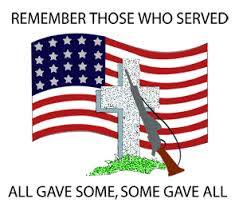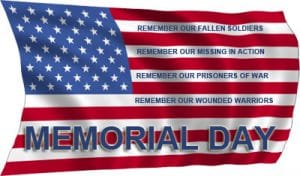

Regardless of the exact date or location of its beginning, one thing is clear – Memorial Day was born out of the Civil War and a desire to honor our dead. It was officially proclaimed on May 5, 1868, by Gen. John Logan, national commander of the Grand Army of the Republic, in his General Order No. 11. “The 30th of May, 1868, is designated for the purpose of strewing with flowers, or otherwise decorating the graves of comrades who died in defense of their country during the late rebellion, and whose bodies now lie in almost every city, village and hamlet churchyard in the land,” he proclaimed. The date of Decoration Day, as he called it, was chosen because it wasn’t the anniversary of any particular battle.
On the first Decoration Day, Gen. James Garfield made a speech at Arlington National Cemetery, and 5,000 participants decorated the graves of the 20,000 Union and Confederate soldiers buried there.
The first state to officially recognize the holiday was New York in 1873. By 1890, it was recognized by all of the northern states. The South refused to acknowledge the day, honoring their dead on separate days until after World War I (when the holiday changed from honoring just those who died fighting in the Civil War to honoring Americans who died fighting in any war).
It is now observed in almost every state on the last Monday in May with Congressional passage of the National Holiday Act of 1971 (P.L. 90 – 363). This helped ensure a three-day weekend for federal holidays, though several southern states have an additional separate day for honoring Confederate war dead: January 19 in Texas; April 26 in Alabama, Florida, Georgia, and Mississippi; May 10 in South Carolina; and June 3 (Jefferson Davis’ birthday) in Louisiana and Tennessee.
Red Poppies
In 1915, inspired by the poem “In Flanders Fields,” Moina Michael replied with her own poem:
We cherish too, the Poppy red
That grows on fields where valor led,
It seems to signal to the skies
That blood of heroes never dies.
She then conceived of an idea to wear red poppies on Memorial Day in honor of those who died serving 
She was the first to wear one, and sold poppies to her friends and co-workers with the money going to benefit servicemen in need. Later a Madam Guerin from France was visiting the United States and learned of this new custom. When she returned to France, she made artificial red poppies to raise money for war-orphaned children and widowed women. This tradition spread to other countries. In 1921, the Franco-American Children’s League sold poppies nationally to benefit war orphans of France and Belgium. The League disbanded a year later and Madam Guerin approached the Veterans of Foreign Wars (VFW) organization for help.
Shortly before Memorial Day in 1922, the VFW became the first veterans’ organization to nationally sell poppies. Two years later, their “Buddy Poppy” program was selling artificial poppies made by disabled veterans. In 1948 the U.S. Post Office honored Michael for her role in founding the National Poppy movement by issuing a red 3-cent postage stamp with her likeness on it.
National Moment of Remembrance
The “National Moment of Remembrance” resolution was passed on Dec 2000 which asks that at 3 p.m. local time, for all Americans “To voluntarily and informally observe in their own way a Moment of remembrance and respect, pausing from whatever they are doing for a moment of silence or listening to ‘Taps.”
Information obtained from www.usmemorialday.org.
Related News
- Overtime Relief for Railroaders Introduced in Congress
- Members’ Videos Spotlight Job Insurance Program (DIPP)
- ATTENTION VETERANS: Update Your Status in TD Connect
- Obituary: York Dudley Poole III
- SMART-TD Reaches Tentative National Agreement with Carriers
- Spotlighting Rail Safety During See Tracks? Think Train® Week
- Shifting Views on Pattern Agreement
- SMART-TD Pride on Full Display for Labor Day 2025
- Congressman Resurrects Attempt to Nullify Federal Two-Person Crew (2-PC) Rule
- SMART-TD Intensifies the Push for Stronger Transit Safety Laws